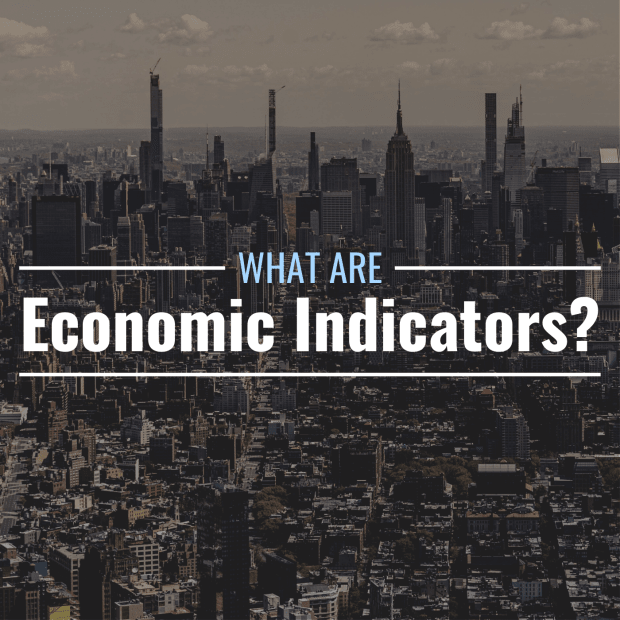
Even outside of the realm of finance, the ubiquitous “economy” is a constant subject of discussion and analysis. Over the years and decades, the U.S. economy has variously been described with words like “struggling,” “slowing,” “thriving,” “robust,” and “growing,” among countless other vague descriptors, both optimistic and ominous.
But just how do analysts arrive at these conclusions about the economic health of the country at large? What clues exist to help the financially curious gaze into the cloudy crystal ball that is the country’s financial future?
The U.S. economy is a complex whole with many moving parts, each of which affects (and is affected by) the others. It involves people, banks, businesses, governmental entities, wages, interest rates, raw materials, supply chains, products, and tradable securities like stocks and bonds. Changes in one part of the economy often bleed into other parts, and that’s why investors, analysts, and financial professionals pay so much attention to economic data.
What Are Economic Indicators & Why Are They Important?
Economic indicators are simply large-scale macroeconomic statistics that shed light on one or more of the many interrelated components of the economy. These can include statistics about production, consumption, employment, wages, real estate, the stock market, and more.
When reports about the current or future health of the economy are shared, this is what they are based on—changes in one or more macroeconomic statistics that indicate something about the state of the economy at large.
Gross Domestic Product, or GDP, for instance, is one of the most commonly followed economic indicators. It is a measure of a country’s total economic output over a certain period (usually a year), or the total value of all final-stage goods and services produced and sold. When GDP increases from one year to the next, analysts say the economy is growing.
Other examples of major economic indicators include the unemployment rate, new-home sales, and the yield curve.
Economic indicators like these are important because they help people, businesses, and governments make financial decisions. For instance, the Federal Reserve might decide to raise interest rates if economic indicators point toward rising inflation. Investors might see the economic indicators pointing toward a looming recession and move money out of riskier investments like stocks and into more stable instruments like money market funds.
What Are the 3 Types of Economic Indicators?
Economic indicators usually fall into one of the three following categories based on the time period they shed light on—in other words, whether they are backward-looking, forward-looking, or offer real-time insight.
Leading Indicators
Leading indicators are sets of data that can be useful in predicting the future state of the economy. In other words, they are forward-looking and may signal a shift in some part of the economy before it occurs.
Because leading indicators are forward-looking, some are based on predictions or estimations rather than factual data. And while they are extremely useful when it comes to informed financial decision-making, they can sometimes prove inaccurate in retrospect.
Lagging Indicators
Lagging indicators are sets of economic data that tend to change after a shift in some aspect of the economy has already happened. In other words, they are backward-looking, which makes them extremely useful in confirming that a predicted change or shift has, in fact, occurred.
Because lagging indicators are backward-looking and based on finalized data, they are considered highly accurate and can be helpful in determining where the U.S. is in its economic cycle.
Coincident Indicators
Coincident indicators are sets of nearly current data. As economic conditions change, coincident indicators change more or less simultaneously. While some coincident indicators are actually slightly lagging due to the difficulty of presenting data in real time, they are essentially reflections of the current state of various economic factors.
Because coincident indicators provide close to real-time information, they are particularly useful to policymakers like the Federal Reserve in evaluating whether existing policy measures are working as they should or whether new measures need to be put in place to address economic trends.
Examples of Widely Followed Economic Indicators by Type
There are countless economic indicators used to evaluate the economic status of the country, and different businesses, governmental entities, investors, and economists focus on different groups of indicators for different reasons, but the following are some of the most widely discussed in general.
Leading Indicators
- Yield curve: The yield curve is a graph on which bonds are plotted according to their yield (Y-axis) and term (X-axis). When the yield curve is flat or negative (indicating that the yields of longer-term bonds are dropping toward or below the yields of shorter-term bonds), economic weakness or even recession may be likely in the near future.
- Initial jobless claims: Initial jobless claims refer the number of individuals who filed for unemployment during a given week but did nlot file the week prior, indicating that they just recently became unemployed. Initial jobless claims tend to increase ahead of economic weakness and decrease ahead of economic strength and growth.
- Building permits & housing starts: Building permits represent the number of new approvals for construction on new or existing buildings in a given month, while housing starts represent the number of new construction projects that have actually begun that month. Both are considered good forward-looking economic predictors, as when they increase, it indicates that builders are optimistic about upcoming demand for real estate, and when they fall, it indicates that builders expect demand for real estate to fall.
- Money supply: Money supply refers to the total amount of money circulating in the economy at any given time. Higher money supply typically signals a strong near-future economy with plenty of spending, while lower money supply can sometimes signal upcoming economic contraction.
Lagging Indicators
- Consumer price index: CPI is an aggregate weighted measure of the average prices of goods and services in the U.S., and changes in CPI over time are used to measure inflation. CPI is a lagging indicator because when it goes up, it shows that inflation has already occurred, and when it goes down, it shows that deflation has already occurred.
- Unemployment rate: The unemployment rate is the percentage of work-seeking Americans who are currently unemployed. The unemployment rate goes up when the economy has already begun to weaken, and when it goes back up, it signals that the economy has already started to recover.
- Industrial production & capacity utilization: Industrial production and capacity utilization measure manufacturing output, which tends to correlate to consumer spending and GDP. Because this data is released a month after the fact, most consider IP/CU to be a lagging indicator.
Coincident Indicators
- Gross domestic product: While GDP (essentially the country’s economic output) is technically a lagging indicator, as data is released after each month’s end, many consider it an honorary coincident indicator, as it is the primary measure of the state of the U.S. economy, and it tends to change relatively slowly.
- Personal income: Personal income is considered a coincident indicator because higher income tends to coincide with a strong, healthy economy, while lower income tends to be concurrent with a weaker economy.
- Nonfarm payrolls: Nonfarm payrolls measure employment positions in the private sector and government added or lost each month. Again, this is technically a lagging indicator, but most consider it coincident because it tends to move up and down in close step with the health of the economy. More jobs tend to indicate a growing economy, while fewer jobs signal a weakening one.







